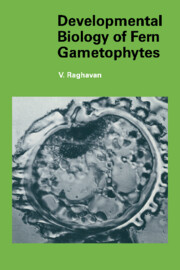Book contents
- Frontmatter
- Contents
- Preface
- Abbreviations
- 1 Introduction
- PART I THE BEGINNING
- PART II GROWTH AND MATURATION
- PART III REPRODUCTIVE STRATEGIES
- PART IV DEVELOPMENTAL OPTIONS
- 13 Apogamy – an alternate developmental program of gametophytes
- 14 Apospory – formation of gametophytes without meiosis
- References
- Author index
- Subject index
13 - Apogamy – an alternate developmental program of gametophytes
Published online by Cambridge University Press: 11 September 2009
- Frontmatter
- Contents
- Preface
- Abbreviations
- 1 Introduction
- PART I THE BEGINNING
- PART II GROWTH AND MATURATION
- PART III REPRODUCTIVE STRATEGIES
- PART IV DEVELOPMENTAL OPTIONS
- 13 Apogamy – an alternate developmental program of gametophytes
- 14 Apospory – formation of gametophytes without meiosis
- References
- Author index
- Subject index
Summary
Fertilization which heralds the diploid or sporophytic phase, is a normal feature in the life cycle of ferns and partly accounts for the typical alternation of generations. A number of fern species also exhibit a way of life in which a sporophyte with the gametic number of chromosomes is born out of the gametophytic cell without fertilization. From both developmental and cytological perspectives, the parenchymatous cell of the gametophyte, dedifferentiating as it does during transformation into a sporophyte, is an obvious target for experimental analysis. With the accounts of sexual reproduction presented in previous chapters as a background, we will explore here the methods and mechanisms by which a sporophyte is regenerated from the gametophyte, while keeping innocent of sex.
Apogamy is the preferred term used to designate the developmental and reproductive adaptation of gametophytic cells that are deflected into the sporophytic pathway without sexual union. The term as used generally includes the regeneration of any organ of the sporophyte from the cells of the gametophyte. In some early accounts of apogamy, the term was extended to include production within the gametophyte of characteristic tissue elements of the sporophyte such as tracheids. However, as gametophytes that do not regenerate apogamous sporophytes differentiate tracheids, when supplied with sucrose or hormones in the medium (see chapter 9), it would seem logical to consider apogamous regeneration and tracheid differentiation as separate processes.
- Type
- Chapter
- Information
- Developmental Biology of Fern Gametophytes , pp. 261 - 279Publisher: Cambridge University PressPrint publication year: 1989
- 2
- Cited by



